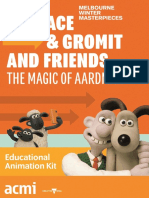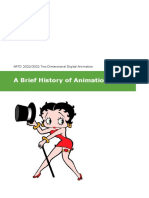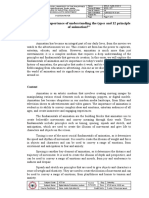The Evolution and Impact of Animation in Media and Culture
Animation has been a transformative medium in the entertainment industry, blending artistry,
technology, and storytelling. From its humble beginnings as a rudimentary form of entertainment
to its modern-day status as a central pillar in both children’s and adult media, animation has
revolutionized how stories are told, how audiences engage with content, and how creators
envision narratives. This essay explores the history, technological advancements, and cultural
significance of animation, with a focus on its impact on both the entertainment industry and
society at large.
The Origins of Animation
The origins of animation can be traced back to the late 19th century when pioneers in the field
began experimenting with visual techniques to create the illusion of movement. Early forms of
animation, such as phenakistoscopes and zoetropes, used simple mechanical devices to
produce moving images by rapidly displaying individual frames. The first widely recognized
animated film, Gertie the Dinosaur (1914), created by Winsor McCay, marked a significant leap
forward in the animation industry. McCay’s groundbreaking work showcased animation as a
potential storytelling medium and laid the groundwork for future developments in animation
techniques.
As animation began to evolve, the introduction of the first full-length animated feature, Snow
White and the Seven Dwarfs (1937), by Walt Disney, solidified animation’s potential as a form of
cinematic storytelling. Disney’s masterpiece not only demonstrated the potential for animation to
tell rich, emotionally engaging stories but also paved the way for the rise of animation studios
and the development of distinct animation styles. This film established animation as an art form
that could captivate audiences of all ages, creating a new paradigm for entertainment.
Technological Advancements and the Rise of Computer Animation
The 1990s marked a pivotal moment in the evolution of animation, thanks to the advent of
computer-generated imagery (CGI). Films like Toy Story (1995), produced by Pixar, heralded a
new era in animation, offering a completely new visual aesthetic compared to traditional
hand-drawn animation. Pixar’s innovation with CGI, along with other studios’ embrace of the
technology, changed the landscape of animation by allowing for more detailed, dynamic, and
visually striking animations. CGI also introduced new storytelling possibilities, with films like
Shrek (2001) and The Incredibles (2004) combining complex visual effects with engaging
narratives and humor that appealed to both children and adults.
The advent of digital tools and software like Autodesk Maya and Adobe Animate also made
animation more accessible to independent creators and smaller studios. The rise of these tools
democratized animation production, enabling more diverse voices and a wider range of creative
works to emerge. This democratization has given rise to the internet-based animation industry,
where web series like Avatar: The Last Airbender (2005-2008) and BoJack Horseman
�(2014-2020) have garnered substantial followings, showcasing that animation is no longer
confined to children’s content alone.
The Cultural Impact of Animation
Animation has had a profound impact on global culture, influencing not only entertainment but
also fashion, art, and even politics. Animated characters like Mickey Mouse, Bugs Bunny, and
Homer Simpson have become iconic figures, shaping public consciousness and transcending
their origins in animated films and series. These characters often serve as cultural symbols,
representing different eras or societal trends, and they continue to play significant roles in
advertising, branding, and other commercial ventures.
Moreover, animation has become a powerful tool for addressing complex societal issues. The
2009 film Up is an example of how animated films can tackle themes such as loss, love, and
resilience in a way that resonates with both children and adults. Similarly, shows like The
Simpsons and South Park have used satire and humor to address political issues, societal
norms, and human behavior, demonstrating animation's ability to engage with real-world
concerns while entertaining audiences.
Animation also has a significant impact on international cultures, as seen in the global success
of Japanese anime. Works such as Spirited Away (2001) by Hayao Miyazaki have introduced
audiences worldwide to new visual styles, storytelling techniques, and cultural narratives. Anime
has become a powerful force in global entertainment, with its distinctive art style and often
mature themes attracting diverse audiences beyond Japan. This cultural exchange
demonstrates how animation can bridge geographic and linguistic barriers, fostering
cross-cultural understanding.
Animation’s Role in Contemporary Media
Today, animation continues to evolve in new and exciting ways, with advancements in virtual
reality (VR), augmented reality (AR), and interactive media pushing the boundaries of what
animation can achieve. VR experiences like Wolves in the Walls (2018) allow users to immerse
themselves in animated worlds, blurring the lines between traditional animation and interactive
entertainment. Furthermore, streaming platforms such as Netflix, Disney+, and Hulu have
become major players in the animation industry, commissioning original animated content and
making animated series and films more accessible to audiences worldwide.
Animation’s influence has also expanded into advertising, video games, and education.
Animated advertisements, often featuring beloved characters or engaging visuals, are a
common method of capturing consumer attention. In the video game industry, animation and
motion capture technology create increasingly realistic and interactive virtual worlds, further
solidifying animation's role as a cornerstone of modern entertainment. Educational programs
and platforms like Sesame Street (1969-present) continue to use animation as a tool to teach
children vital skills, demonstrating the medium’s versatility and ability to communicate important
lessons in an engaging format.
�Conclusion
In conclusion, animation has evolved from its early, experimental roots to become one of the
most influential and versatile mediums in modern media and culture. Through technological
advancements and its cultural impact, animation has transcended its traditional role as
children's entertainment to become a significant force in adult-oriented media, education, and
advertising. As animation continues to innovate and evolve, it will undoubtedly remain a central
form of storytelling that engages, inspires, and entertains audiences of all ages and
backgrounds.
References
● Bendazzi, G. (2016). Animation: A World History. CRC Press.
● Clements, J., & McCarthy, H. (2006). The Art of Animation: From Mickey Mouse to the
Modern Age. The Overlook Press.
● Goggans, S. (2011). Animated Futures: The Fall and Rise of Animation in America.
University of Minnesota Press.
● Wells, P. (1998). Animation and America. Rutgers University Press.
● Zipes, J. (2006). Fairy Tales and the Art of Subversion. Routledge.




















































































